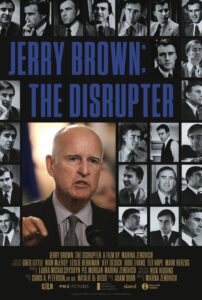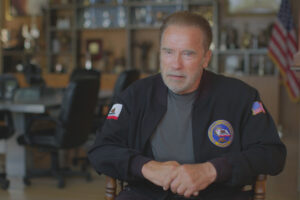DOC NYC Review: Jerry Brown Disrupts in Lively “Jerry Brown: The Disrupter”
Written by: Christopher Llewellyn Reed | November 21st, 2022

Jerry Brown: The Disrupter (Marina Zenovich, 2022) 3½ out of 4 stars.
Born in 1938, Edmund G. Brown Jr. (aka “Jerry” Brown) would go on to serve as Democratic governor of California in two very different eras, the first time from 1975 to 1983 and the second from 2011 to 2019. Given the sobriquet “Governor Moonbeam” by Chicago columnist Mike Royko, Brown was a leading liberal voice at a time when America was about to move more to the right, pursuing green initiatives that soon became what California was known for. His final two terms in office, however, coming so much later in life, were the most surprising, transforming the state’s economy from debt-ridden to surplus-filled. In Jerry Brown: The Disrupterdirector Marina Zenovich (Robin Williams: Come Inside My Mind) explores the life and career of this remarkable politician, in all his occasionally ornery glory.
Brown did not come to the political arena a neophyte. The son of Edmund G. Brown Sr. (or “Pat” Brown)—himself a two-term governor of the state (and former Attorney General)—young Jerry was steeped in politics from an early age. Though he flirted with the Catholic priesthood, Jerry Brown would eventually go to law school and then, in 1970, run for California’s Secretary of State, a position he would win, allowing him to work directly opposite Governor Ronald Reagan, the man who had defeated his father’s bid for a third term. In short, Brown was a man of both many interests and great ambition, and when elected to the governorship in 1974, as one of the youngest in state history, was determined to usher in the ideals of a new generation.

And that he proceeded to do, first by appointing an extremely diverse cabinet, filled with women and people of color. He also oversaw the passage of a farm-labor bill, working together with activist Cesar Chavez, making California the only state (to this day) to have such legislation. And then there were the actions he took on climate change, sounding the clarion call about global warming long before other lawmakers saw the dangers. His mantra, as stated here, was always “What could I do as governor that if I weren’t here wouldn’t get done.” No human being in a democracy works alone, however, and the compromises he was forced to make on taxes and other policies led to a tough 1978 reelection and a far more contentious second term, after which he retired from elected office for a while.
In the middle of all that, he twice ran for President, first in 1976 (with some delegate success) and then again in 1980 (winning only one delegate). He would try once more in 1992, proving almost a spoiler to Bill Clinton’s chances, though the Democratic National Committee closed ranks against him. That third attempt followed time spent traveling the globe, meeting Mother Teresa, and falling in love (with Anne Gust, whom he would eventually marry). And then, in 1998, he jumped back into California politics, this time as Mayor of Oakland, and then in 2006 as Attorney General, working alongside another Republican governor, Arnold Schwarzenegger. Finally, in 2010, as the state was in economic distress following the 2008 housing crisis, he became governor again, serving two more terms and proving, even more than before, that he was both committed to progressive causes and an excellent administrator. Governor Gavin Newsom, currently in power, has Brown to thank for the solid state of his state.

All of this story is fluidly told by Zenovich, who had apparently ample access to Brown, and by the many interviewees she features. These include: the man himself; his wife Anne; sister Kathleen (a lawyer who also served, in the 1990s, as Treasurer of California); Gray Davis, Brown’s Chief of Staff in his first two terms, and later also governor (recalled by voters and replaced by Schwarzenegger); Schwarzenegger; and many other folks who worked as staff or volunteered for campaigns. It’s a lively movie, praising its subject throughout but hardly a hagiography, unafraid to look closely at Brown’s flaws. Indeed, we open and close on Jerry Brown refusing to answer direct questions from Zenovich, preferring to push her to ask something more meaningful (as he sees it). Sure, that makes him a typical curmudgeon, but it’s also a hallmark of who he was and is: never satisfied with the status quo, an eternal disrupter. Nothing wrong with that.

